Squabbles, Spats, and other Shenanigans
Now that we've gotten the gist of the type of events I'd like to investigate in Tiger Tracks, I want to take a side tangent to discuss something that comes up quite regularly: physical altercations between the title characters. More specifically, this is going to be any incident wherein Hobbes' actions leave Calvin injured or otherwise inconvenienced.
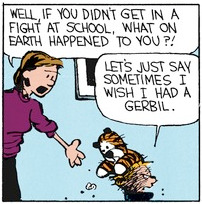
This definition covers a lot of ground. Altercations that get a little too heated. A feline tendency to pounce on someone returning home from school. An unexpected snowball or water balloon ambush. When these sorts of things happen, we have to ask: if Hobbes isn't the culprit, then why would Calvin do this to himself?
I can think of two explanations, neither of which is necessarily excludes the other. Both are predicated on different aspects of Calvin's personality.
First, one of Calvin's most dominating traits is his impulsiveness. He rarely examines the long-term implications of his actions, preferring to throw himself all-in as soon as a favorable thought enters his mind. Obviously, this kind of impulsiveness is going to lead to incidents where a bit more forethought could have avoided something undesirable. In other words, Calvin is absolutely primed for regret.
And you know what's easier than self-reflection? Blaming somebody else. Rather than ever taking responsibility for his mistakes, Calvin is quick to fault absolutely any other potential phenomenon, no matter how outlandish the explanation might be. A stuffed animal companion serves as an easy scapegoat for any negative consequences that Calvin doesn't want to admit were his own doing, or otherwise needs an alternate interpretation for. At times, you have to ask yourself: did Hobbes really hit Calvin with a water balloon? Or did Calvin simply toss it skyward, intending to catch it, only to end up misjudging its arc?
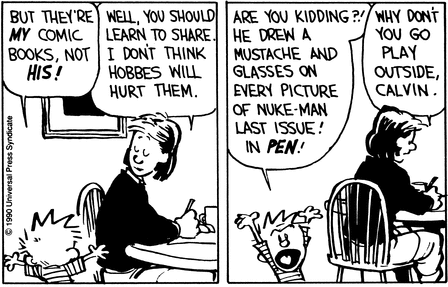
The second of Calvin's aspects to consider is his performative nature. The kid wants to be seen and demands to be heard. To put it another way: it's clear he craves attention. I'm not here to judge whether or not this behavior is cause for concern; I am simply stating facts, and the fact is, Calvin is entirely unafraid to allow himself to be carried away by his own imagination—even when it doesn't paint him in the most positive light.

I mentioned in the preface that any of Hobbes' actions seen only through Calvin's eyes can't be relied upon to be an accurate reflection of events. But with these additional considerations, I think it's worth extending this limitation to any self-inflicted inconvenience or injury, even in cases where the aftermath of such is witnessed by a third party, on the basis that it may simply be "Calvin being Calvin".
Let's utilize this logic on what may be the most inexplicable of these types of events, if you do suppose that Hobbes has zero direct influence on the world. If we can apply the logic to this case, we can apply it to all others.
In the strip published January 13th, 1994, Calvin pelts Hobbes with a snowball, then pridefully gloats about the skill required for such a direct hit. Hobbes is less than impressed, and in the final panel, we see:
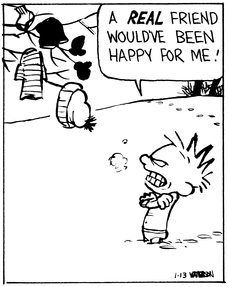
The implication is that, in retaliation, Hobbes has stripped Calvin of his winter clothes and hung them off of a tree branch just out of Calvin's reach. There is no reason to doubt this interpretation of events; and yet, I must, for that is the nature of this series. So if we assume that Calvin is acting entirely of his own accord, with no influence from a tiger of any kind, then we have a few difficult questions to answer:
- Why did Calvin choose to strip down to his underwear in winter?
- Would he even be capable of hanging his clothes high up in a tree?
- Why would he then stare at the clothes, shivering and blaming this outcome on Hobbes?
Questions 1 and 2 are easy. For the first, it's well-established that Calvin has a history of removing his clothes outdoors:
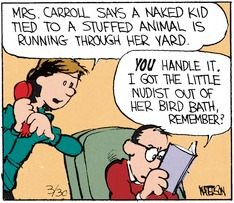
For the second, we see a number of examples of Calvin in a tree throughout the comic's run. In every instance, he is with Hobbes, so common counter-points to this might be "Hobbes gave him a boost"; but this thought experiment assumes that Hobbes cannot interact with the world, so this point is moot. A more plausible argument might be "you claim Calvin is an unreliable narrator, so we can't trust that he's been in a tree", but this is disproven thanks to Mom:
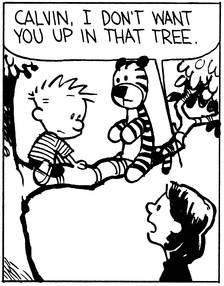
So point number 3 is really the most difficult to wrap our minds around. At least... it would appear that way. But actually, we just presented the solution in the previous paragraph: Calvin is an unreliable narrator. What we're seeing is Calvin's attempt to justify his actions after Mom had to once again come collect her half-naked son and pull his clothes down from a tree. Perhaps the version of events we are shown is what Calvin has deluded himself into believing actually occurred; or, slightly less concerningly, is simply part of the lie he is spinning to avoid discipline.
Yes, it does seem odd that Watterson would present us with an event that, in fact, did not happen. Except, when you consider how often Calvin's imagination is depicted by the strip, you'll find that in actuality, it's not unusual at all. Thus, I think it's safe to generally skip over these instances and consider them just another product of Calvin's, shall we say, "creativity".
Verdict: Man this kid has issues though.